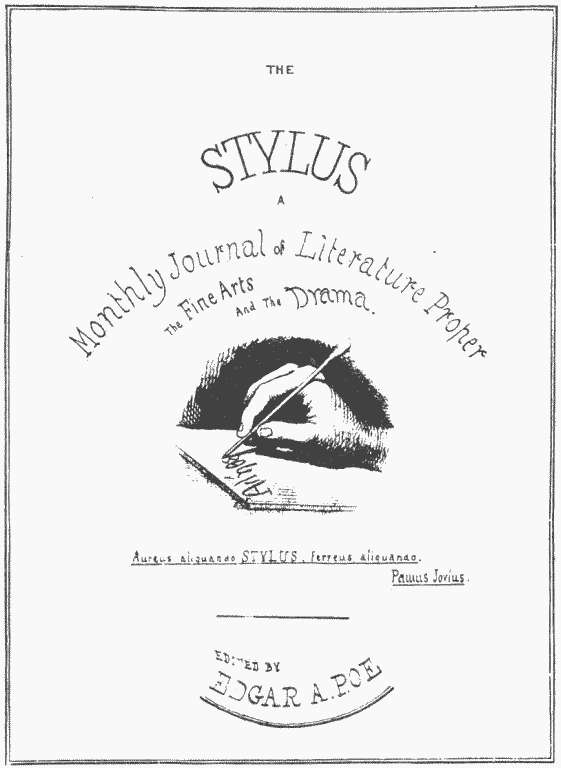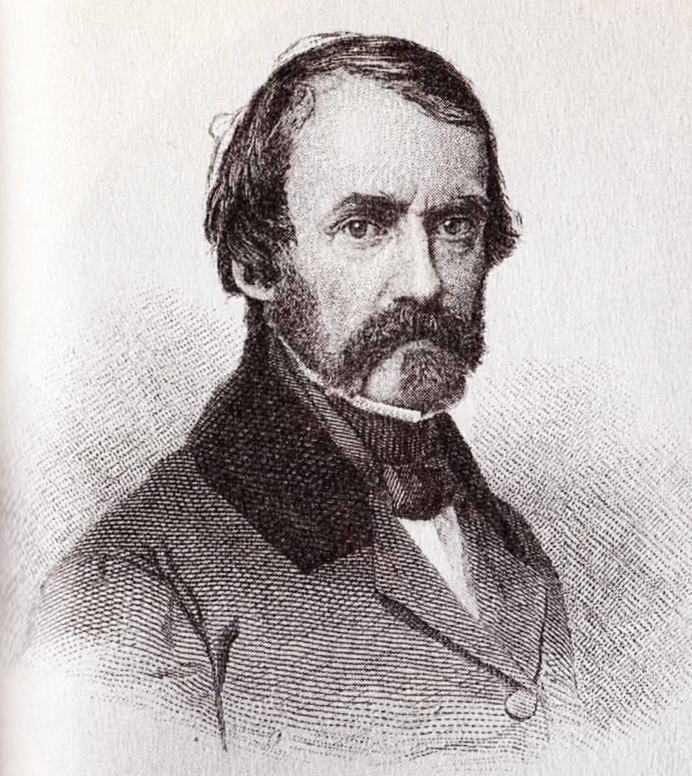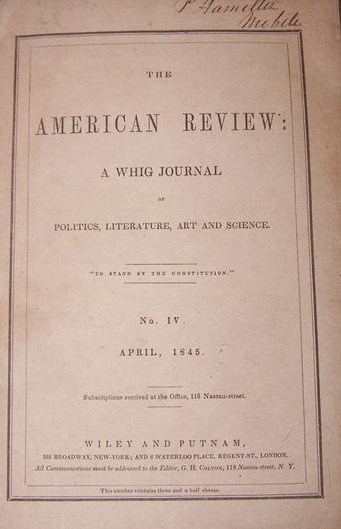|
American Whig Review
''The American Review'', alternatively known as ''The American Review: A Whig Journal'' and ''The American Whig Review'', was a New York City-based monthly periodical that published from 1844 to 1852. Published by Wiley and Putnam, it was edited by George H. Colton (1818–1847), and after his death, beginning with Volume 7, by James Davenport Whelpley. As of Volume 10, July 1849, the proprietors of the journal were Whelpley and John Priestly. History The first issue of ''American Review'' was dated January 1845, though it was likely published as early as October 1844, and intended to promote the Whig candidate Henry Clay, running in the presidential election of 1844. Clay was opposed by James K. Polk, the Democratic Party’s candidate, who had the support of the '' Democratic Review''. In December 1844, Edgar Allan Poe was recommended as an editorial assistant by James Russell Lowell, though Poe was not hired.Sova, Dawn B. ''Edgar Allan Poe: A to Z''. New York: Checkmark Books, ... [...More Info...] [...Related Items...] OR: [Wikipedia] [Google] [Baidu] |
Wiley & Putnam
John Wiley & Sons, Inc., commonly known as Wiley (), is an American multinational publishing company founded in 1807 that focuses on academic publishing and instructional materials. The company produces books, journals, and encyclopedias, in print and electronically, as well as online products and services, training materials, and educational materials for undergraduate, graduate, and continuing education students. History The company was established in 1807 when Charles Wiley opened a print shop in Manhattan. The company was the publisher of 19th century American literary figures like James Fenimore Cooper, Washington Irving, Herman Melville, and Edgar Allan Poe, as well as of legal, religious, and other non-fiction titles. The firm took its current name in 1865. Wiley later shifted its focus to scientific, technical, and engineering subject areas, abandoning its literary interests. Wiley's son John (born in Flatbush, New York, October 4, 1808; died in East Orange, New Jers ... [...More Info...] [...Related Items...] OR: [Wikipedia] [Google] [Baidu] |
Pseudonym
A pseudonym (; ) or alias () is a fictitious name that a person or group assumes for a particular purpose, which differs from their original or true name (orthonym). This also differs from a new name that entirely or legally replaces an individual's own. Many pseudonym holders use pseudonyms because they wish to remain anonymous, but anonymity is difficult to achieve and often fraught with legal issues. Scope Pseudonyms include stage names, user names, ring names, pen names, aliases, superhero or villain identities and code names, gamer identifications, and regnal names of emperors, popes, and other monarchs. In some cases, it may also include nicknames. Historically, they have sometimes taken the form of anagrams, Graecisms, and Latinisations. Pseudonyms should not be confused with new names that replace old ones and become the individual's full-time name. Pseudonyms are "part-time" names, used only in certain contexts – to provide a more clear-cut separation between o ... [...More Info...] [...Related Items...] OR: [Wikipedia] [Google] [Baidu] |
Magazines Disestablished In 1852
A magazine is a periodical publication, generally published on a regular schedule (often weekly or monthly), containing a variety of content. They are generally financed by advertising, purchase price, prepaid subscriptions, or by a combination of the three. Definition In the technical sense a ''journal'' has continuous pagination throughout a volume. Thus ''Business Week'', which starts each issue anew with page one, is a magazine, but the '' Journal of Business Communication'', which continues the same sequence of pagination throughout the coterminous year, is a journal. Some professional or trade publications are also peer-reviewed, for example the '' Journal of Accountancy''. Non-peer-reviewed academic or professional publications are generally ''professional magazines''. That a publication calls itself a ''journal'' does not make it a journal in the technical sense; ''The Wall Street Journal'' is actually a newspaper. Etymology The word "magazine" derives from Arabic , th ... [...More Info...] [...Related Items...] OR: [Wikipedia] [Google] [Baidu] |
Magazines Established In 1844
A magazine is a periodical publication, generally published on a regular schedule (often weekly or monthly), containing a variety of content. They are generally financed by advertising, purchase price, prepaid subscriptions, or by a combination of the three. Definition In the technical sense a ''journal'' has continuous pagination throughout a volume. Thus ''Business Week'', which starts each issue anew with page one, is a magazine, but the '' Journal of Business Communication'', which continues the same sequence of pagination throughout the coterminous year, is a journal. Some professional or trade publications are also peer-reviewed, for example the '' Journal of Accountancy''. Non-peer-reviewed academic or professional publications are generally ''professional magazines''. That a publication calls itself a ''journal'' does not make it a journal in the technical sense; ''The Wall Street Journal'' is actually a newspaper. Etymology The word "magazine" derives from Arabic , th ... [...More Info...] [...Related Items...] OR: [Wikipedia] [Google] [Baidu] |
Defunct Literary Magazines Published In The United States
{{Disambiguation ...
Defunct (no longer in use or active) may refer to: * ''Defunct'' (video game), 2014 * Zombie process or defunct process, in Unix-like operating systems See also * * :Former entities * End-of-life product * Obsolescence Obsolescence is the state of being which occurs when an object, service, or practice is no longer maintained or required even though it may still be in good working order. It usually happens when something that is more efficient or less risky r ... [...More Info...] [...Related Items...] OR: [Wikipedia] [Google] [Baidu] |
The Stylus
''The Stylus'', originally intended to be named ''The Penn'', was a would-be periodical owned and edited by Edgar Allan Poe. It had long been a dream of Poe to establish an American journal with very high standards in order to elevate the literature of the time. Despite attempts at signing up subscribers and finding financial backers and contributors, the journal never came to be. Overview Though Poe thought of creating the journal as early as 1834, he first announced his prospectus in June 1840 immediately after leaving ''Burton's Gentleman's Magazine''.Meyers, 119 Originally, Poe intended to call the journal ''The Penn'', as it would have been based in Philadelphia, Pennsylvania. In the June 6, 1840, issue of Philadelphia's ''Saturday Evening Post'', Poe purchased advertising space for his prospectus: "PROSPECTUS OF THE PENN MAGAZINE, a Monthly Literary Journal, to be Edited and Published in the city of Philadelphia, by Edgar A. Poe." Many were looking forward to the magazine, i ... [...More Info...] [...Related Items...] OR: [Wikipedia] [Google] [Baidu] |
Southern Literary Messenger
The ''Southern Literary Messenger'' was a periodical published in Richmond, Virginia, from August 1834 to June 1864, and from 1939 to 1945. Each issue carried a subtitle of "Devoted to Every Department of Literature and the Fine Arts" or some variation thereof and included poetry, fiction, nonfiction, reviews, and historical notes. It was founded by Thomas Willis White, who served as publisher and occasional editor until his death, in 1843. White hired Edgar Allan Poe in 1835 as a staff writer and critic. Others involved with the periodical included Matthew Fontaine Maury and Maury's kinsman Benjamin Blake Minor. Publication ended in June 1864, in part because of Richmond's involvement in the American Civil War, and was revived from 1939–1945. History The ''Southern Literary Messenger'' first appeared in August 1834 with Thomas Willis White (1788–1843) as publisher. In the inaugural issue, he stated that his aim was "to stimulate the pride and genius of the south, and awaken f ... [...More Info...] [...Related Items...] OR: [Wikipedia] [Google] [Baidu] |
Graham's Magazine
''Graham's Magazine'' was a nineteenth-century periodical based in Philadelphia established by George Rex Graham and published from 1840 to 1858. It was alternatively referred to as ''Graham's Lady's and Gentleman's Magazine'' (1841–1842, and July 1843 – June 1844), ''Graham's Magazine of Literature and Art'' (January 1844 – June 1844), ''Graham's American Monthly Magazine of Literature and Art'' (July 1848 – June 1856), and ''Graham's Illustrated Magazine of Literature, Romance, Art, and Fashion'' (July 1856 – 1858). The journal was founded after the merger of ''Burton's Gentleman's Magazine'' and ''Atkinson's Casket'' in 1840. Publishing short stories, critical reviews, and music as well as information on fashion, Graham intended the journal to reach all audiences including both men and women. He offered the high payment of $5 per page, successfully attracting some of the best-known writers of the day. It also became known for its engravings and artwork. ''Graham's'' m ... [...More Info...] [...Related Items...] OR: [Wikipedia] [Google] [Baidu] |
Burton's Gentleman's Magazine
''Burton's Gentleman's Magazine and American Monthly Review'' (sometimes ''...and Monthly American Review'' or, more simply, ''Burton's Magazine''), was a literary publication published in Philadelphia from 1837 to 1840. Its founder was William Evans Burton, an English-born immigrant to the United States who also managed a theatre and was a minor actor. Edgar Allan Poe was an editor and contributor in 1839–40. Overview William Evans Burton teamed with publisher Charles Alexander to produce a magazine inspired by the successful''The Gentleman's Magazine'' in London. To offset the financial adversity amidst the Panic of 1837, they focused on local authors and nationalist themes, signaled in part by a frontispiece with both patriotic and gentlemanly imagery as well as an illustration of Benjamin Franklin. Burton hoped to create a magazine that would be "worthy of a place upon every parlour table of every gentleman in the United States".Sova, Dawn B. ''Edgar Allan Poe: A to Z''. Ne ... [...More Info...] [...Related Items...] OR: [Wikipedia] [Google] [Baidu] |
Broadway Journal
The ''Broadway Journal'' was a short-lived New York City-based newspaper founded by Charles Frederick Briggs and John Bisco in 1844 and was published from January 1845 to January 1846. In its first year, the publication was bought by Edgar Allan Poe, becoming the only periodical he ever owned, though it failed after only a few months under his leadership. History Briggs, previously known as a satire novelist under the pseudonym "Harry Franco", wrote a letter to James Russell Lowell on December 7, 1844, announcing his intentions to start a journal. "The name will be, for the sake of individuality and a-part-from-other-peopleness, the Broadway Journal, or Review, or Chronicle, or Broadway Something". Upon its founding as the ''Broadway Journal'', Briggs handled the editorial duties and solicited for contributors while his business partner John Bisco handled the publishing and financial concerns. On February 21, 1845, Edgar Allan Poe signed a year-long contract to become an editor ... [...More Info...] [...Related Items...] OR: [Wikipedia] [Google] [Baidu] |
The Facts In The Case Of M
''The'' () is a grammatical article in English, denoting persons or things already mentioned, under discussion, implied or otherwise presumed familiar to listeners, readers, or speakers. It is the definite article in English. ''The'' is the most frequently used word in the English language; studies and analyses of texts have found it to account for seven percent of all printed English-language words. It is derived from gendered articles in Old English which combined in Middle English and now has a single form used with pronouns of any gender. The word can be used with both singular and plural nouns, and with a noun that starts with any letter. This is different from many other languages, which have different forms of the definite article for different genders or numbers. Pronunciation In most dialects, "the" is pronounced as (with the voiced dental fricative followed by a schwa) when followed by a consonant sound, and as (homophone of pronoun ''thee'') when followed by a v ... [...More Info...] [...Related Items...] OR: [Wikipedia] [Google] [Baidu] |
Some Words With A Mummy
"Some Words with a Mummy" is a satirical short story by American writer Edgar Allan Poe. It was first published in '' The American Review: A Whig Journal of Politics, Literature, Art and Science'' in April 1845. It is recognized as an important early portrayal of a revived Egyptian mummy. Plot The narrator eats a very large amount of Welsh rabbit, accompanied by "brown stout", and then goes to bed for a night's sleep. However, he is soon awakened and taken to Doctor Ponnonner's home to witness the unwrapping of a mummy. They cut into the first sarcophagus, remove it and discover the mummy's name, Allamistakeo. The second and third sarcophagi are removed to reveal the body, placed in a papyrus sheath, covered in plaster and decorated with painting and gold gilt. After removing this, they examine the body. They find it to be in exceptionally good condition, although it does not seem to have been embalmed in the normal way as the skin is red and there are no incisions. The doctor lay ... [...More Info...] [...Related Items...] OR: [Wikipedia] [Google] [Baidu] |









.png)
